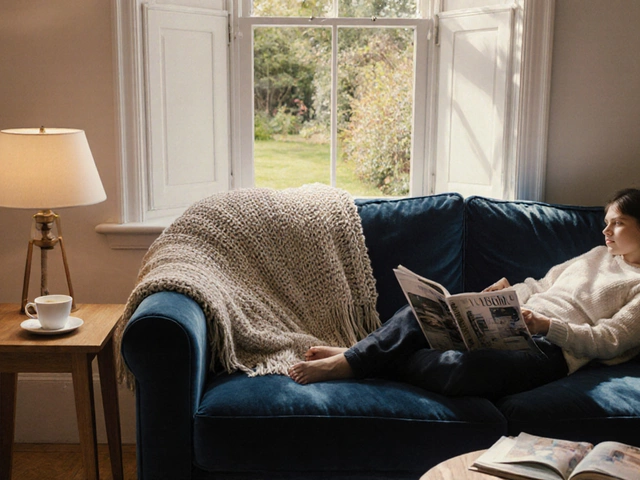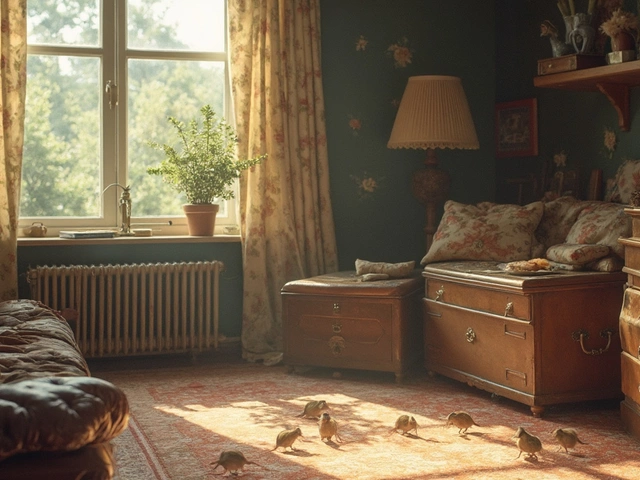Ever pulled your stuff out of storage and found mold creeping across your favorite sofa? Annoying, right? Mold can be a real problem when you stash furniture away, especially if conditions aren't right. So, why does this happen, and more importantly, how do you stop it?
First off, mold loves moisture. Any dampness in the air makes a perfect playground for those pesky spores. They can turn a damp corner into mold city in no time. This is why choosing the right storage unit is crucial. But how do you know what's right?
Climate control in storage units might sound fancy, but it’s often worth it. Maintaining a consistent temperature and humidity level can really help keep the mold at bay. But if climate control’s too pricey, don’t worry—there are other tricks to try.
Before you even think about putting that chair in storage, prepare it properly. Clean and dry your furniture thoroughly. No damp cloths left behind, and no wet spots, please. Prevention is the name of the game when it comes to mold.
- Understanding Why Mold Grows
- Choosing the Right Storage Unit
- Climate Control: Is It Necessary?
- Preparing Furniture for Storage
- Preventive Measures Against Mold
- What to Do if Mold Appears
Understanding Why Mold Grows
Mold is one of those things you don't think about until it's right there, making a mess of things. So, how does it all go wrong? Well, mold thrives in damp and humid environments, making moisture the main culprit here.
Moisture: The Mold Magnet
Any time you store furniture without considering the humidity, you're playing a dangerous game. Mold spores are naturally in the air, just waiting for a little dampness to start growing. A little moisture in a dark, unventilated storage room is like an open invitation for these pesky intruders.
Temperature and Ventilation
Temperature and ventilation are two key factors in keeping mold away. Mold loves it when it's warm and stuffy, so a closed-off space is basically mold heaven. Temperature fluctuations can also lead to condensation, and we all know how well moisture and mold get along.
Organic Material: Mold's Best Friend
Mold feeds on organic material, and wouldn't you know it, most furniture is made from stuff like wood, fabric, and even leather, all prime mold food sources. This makes proper storage especially critical for preserving the quality of your furniture over time.
Interesting Fact
Did you know that mold can start to grow within just 24 to 48 hours under the right conditions? That’s why it’s so critical to stay ahead of the game when it comes to storing your stuff.
Understanding these factors can help you make better decisions about where and how to store your furniture, keeping it safe from the sneaky spread of mold. Stick around as we dive into more tips about choosing the right storage unit and prepping your furnishings for their storage stint.
Choosing the Right Storage Unit
Finding the perfect spot for your furniture storage is a bit like choosing a home for your stuff—you're looking for safety and comfort. First, consider how long you'll be storing everything. Short-term? Just about any decent unit will do. But if it's long-term, think ahead about mold risks.
Let's talk about climate control. It's not just a fancy add-on. Temperature and humidity swings can spell disaster for furniture. Wood can warp, and fabrics can get damp. Climate-controlled units keep everything steady, and that stability stops mold in its tracks.
Location and Accessibility
Where your storage unit is located matters. Units on the outer edge of a facility might be more exposed to elements. If you're in a humid area, opt for indoor units. Of course, convenience counts, too. You don't want to drive miles just to reach your stuff.
Unit Size and Layout
Size isn't just about fitting everything in—you'll want some space to breathe. Packed like sardines? Moisture can get trapped. Pick a size that lets you leave gaps for air flow. Arrange furniture smartly, so air can circulate around the edges.
Security Features
Can't forget safety. A quality storage place will have good security—cameras, lighting, and controlled access. That way, you're not just protecting against mold, but against thieves, too.
When you're checking out options, don't hesitate to ask about these features. Some of the best storage facilities will offer well-rounded packages that include climate control, 24-hour security, and easy access.
Mold prevention starts with the right storage unit, so choose wisely and save yourself the headache later on!
Climate Control: Is It Necessary?
So, you're probably wondering if spending extra for a climate-controlled unit is worth it. Well, let's break it down. When it comes to furniture storage, moisture and temperature swings are the real enemies. Mold loves warmer, damp places, and that's something typical storage spaces can become.
Climate control means the unit maintains steady temperatures and humidity levels. This environment can prevent those dreaded mold spores from finding a foothold. Sure, it's a bit pricier, but think of it like insurance for your furniture. You're paying for peace of mind knowing your stuff won’t come out looking like a science experiment gone wrong.
When Should You Spring for It?
If you're storing wooden furniture, leather sofas, or antiques, climate control can be a lifesaver. These materials are prone to changes in humidity, expanding and contracting with temp shifts, which can lead to warping or cracking. Yikes!
What If It’s Out of Budget?
Can't swing for climate control? No worries. Here are some alternative tips to keep your furniture safe:
- Wrap your items in breathable covers instead of plastic to avoid moisture build-up.
- Use dehumidifiers or moisture absorbers, like silica gel packs, inside the unit.
- Raise furniture off the ground using pallets to keep them dry in case of spills or leaks.
To give you an idea, a climate-controlled unit can cost about 20-50% more than standard storage units. So weigh the cost against the risk of potential damage to your beloved items.

Preparing Furniture for Storage
Getting your furniture ready for storage might seem like a chore, but it’s crucial if you want to protect against mold and damage. A few simple steps can make a huge difference.
Clean Thoroughly
First things first, clean every piece of furniture. Dust, dirt, and spills can turn into mold hotspots once packed away. Use mild soap and water, then let everything dry completely. Remember, moisture is your enemy.
Disassemble If Possible
It might be a bit of a hassle, but disassembling furniture can save space and reduce stress during storage. Plus, smaller pieces dry faster and more completely. Keep an inventory of parts, so nothing goes missing.
Use Protective Covers
Covers are your best friends! Use breathable covers to shield your furniture. Avoid plastic wrap as it can trap moisture, ironically leading to the very mold you’re trying to avoid. Cotton sheets or specialized furniture covers do the trick.
According to the American Society of Furniture Conservators, "Proper preparation and storage are vital to ensure furniture longevity and avoid potential restoration costs."
Strategic Placement
Place furniture on pallets to keep it off the floor. This limits contact with dampness and helps air circulation, discouraging mold. Keep items slightly away from walls, allowing air to circulate freely.
Label and Organize
Label everything clearly, especially disassembled parts. An organized setup ensures easy access and reduces handling, minimizing wear and tear.
Checklist
- Clean all items thoroughly.
- Disassemble where possible.
- Use breathable covers.
- Place on pallets, away from walls.
- Label everything accurately.
Following these tips not only helps prevent mold but also makes the whole process smoother when you decide to retrieve your cherished pieces from storage.
Preventive Measures Against Mold
Keeping your furniture mold-free while in storage might seem like a challenge, but with a few smart moves, it’s totally doable. So, you’ve chosen your unit, and climate control isn’t an option? No worries, there are still plenty of ways to keep mold at bay.
Keep It Dry
One of the easiest ways to prevent mold is to keep your stuff dry. Before storing furniture, make sure everything is completely dry. You might even want to leave things out for a bit longer than you think is necessary. It’s better to dry more than less!
Pack Smart
When packing, avoid wrapping items in plastic, as it can trap moisture. Instead, use breathable materials like old sheets or fabric covers. This allows air to circulate, reducing mold risks.
Use Desiccants
Invest in desiccants, those little packets that absorb moisture. Throw a few into boxes and storage units. You can also use silica gel packs or calcium chloride, both available at hardware stores. These little guys can make a big difference in the fight against moisture.
Regularly Check and Ventilate
If possible, pop in for regular checks to ensure no mold spots are forming. While there, open the unit for a bit to let in fresh air. It’s a simple step, but it can be very effective.
Monitor Humidity Levels
If you have access, place a hygrometer in the unit. This little tool shows humidity levels, giving you a heads-up if things are getting too moist.
| Humidity Level | Mold Growth Risk |
|---|---|
| Below 50% | Low |
| 50% - 60% | Moderate |
| Above 60% | High |
Keep the humidity low, ideally below 50%, and your furniture storage will serve you well.
Implementing these measures can help ensure that your beloved furniture remains in tip-top shape, ready to be enjoyed when you're ready to bring it back out.
What to Do if Mold Appears
Discovering mold on your stored furniture can be a nightmare, but don't panic—it’s fixable. First things first, let's stop the spread. Mold can be contagious to other items, so creating physical distance is a good start.
Steps to Clean Moldy Furniture
- Get it Outside: If possible, move the furniture outdoors. Fresh air and sunlight can help limit mold growth. Plus, you'll keep those spores out of your house.
- Brush It Off: Use a soft-bristled brush to gently sweep off loose mold. You don’t want to scrub too hard and damage the piece, especially if it’s antique.
- Get Cleaning: Mix a bucket of mild detergent and warm water. Using a clean cloth, gently wipe down the molded furniture. Rinse with another damp cloth, and dry it with a towel.
- Use Vinegar: White vinegar is a hero when it comes to killing mold. Spray some on the affected area, wait about an hour, and then wipe it with a clean cloth.
Tackling Serious Mold Infestations
Sometimes, mold is persistent, or it has penetrated the surface deep enough that DIY methods don't make the cut. If the above steps don't do the trick, it might be worth calling in the pros to handle the job. They have specialized tools and techniques for such situations.
Climate control storage was mentioned, right? If there’s a chance of mold, creating a controlled environment afterwards is a smart move. As they say, prevention is better than cure!
Prevent Future Mold Growth
Once you've cleared the mold, you’ll want to prevent it from cropping up again. Double-check ventilation, reduce moisture levels, and keep pieces clean. Well-cared-for, mold-free furniture is just around the corner.



